Central Synagogue
|
Central Synagogue | |
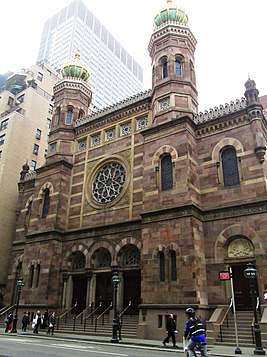 (2017) | |
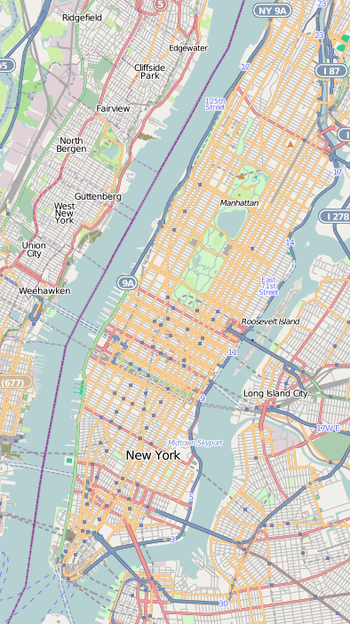  | |
| Location |
646-652 Lexington Avenue[1] Manhattan, New York City |
|---|---|
| Coordinates | 40°45′35″N 73°58′14″W / 40.759592°N 73.970473°WCoordinates: 40°45′35″N 73°58′14″W / 40.759592°N 73.970473°W |
| Built | 1870-72 |
| Architect | Henry Fernbach[2] |
| Architectural style | Moorish Revival |
| Website |
centralsynagogue |
| NRHP reference # | 70000423 [3] |
| Significant dates | |
| Added to NRHP | October 9, 1970 [3] |
| Designated NHL | May 15, 1975[4] |
| Designated NYCL | July 7, 1966[5] |
Central Synagogue (Congregation Ahawath Chesed Shaar Hashomayim)[2] is a Reform synagogue located at 652 Lexington Avenue, at the corner of East 55th Street in Midtown Manhattan, New York City. It was built in 1870-72 and was designed by Henry Fernbach in the Moorish Revival style as a copy of Budapest's Dohány Street Synagogue.[6] It has been in continuous use by a congregation longer than any other in the state of New York,[5][7][8] and is among the oldest synagogue buildings still standing in the United States.[9]
The building was designated a New York City landmark by the New York City Landmarks Preservation Commission in 1966[5] and was added to the National Register of Historic Places in 1970.[3] It was then designated a National Historic Landmark in 1975.[4][7]
On Wednesdays at 12:45 p.m. a docent conducts a free tour, which begins at the front entrance.
History
The Ahawath Chesed congregation was founded in 1846 on Ludlow Street in Manhattan by German-speaking Jews from Bohemia. It merged in 1898 with Congregation Shaar Hashomayim, which was founded by German Jews in 1839 on Albany Street.[5][1][10] The combined congregation bought the lot at Lexington Avenue and East 55th Street and engaged Henry Fernbach, the country's first prominent Jewish architect, to design it.[2]
The dramatic style of the building was the subject of much debate during the construction. Some felt its excess would inspire envy and stand in the way of assimilation.[11]
After a fire in 1886, the building was restored by Ely Jacques Kahn.[2]
The building was restored in the original style after an accidental fire in August 1998,[12] which occurred just as a major renovation was being completed.[1][10] The fire destroyed the roof and its supports. During the fire, the firefighters' sensitivity for the building saved all but the central pane in the rose window that dominates the eastern (Lexington Avenue) wall. Marble plaques on the north wall of the foyer honor the firefighters of the 8th Battalion of the New York City Fire Department. The restoration of the building was supervised by Hugh Hardy of Hardy Holzman Pfeiffer.[1] Hardy restored some details to the interior that Ely Jacques Kahn had removed in the earlier restoration in 1886. The recent restoration was completed on September 9, 2001[2]
Architecture
Although the brownstone exterior is "the finest extant example of the Moorish Revival style in New York City", the plan of the interior is Gothic in nature. The exterior is dominated by two octagonal towers topped by globular domes, as well as by the rose window of geometric design. A small row of arches just below the cornice, at the roof line, adds to the richness of the facade. The north facade, on East 55th Street, features six stained-glass windows framed by Moorish arches.[5][1] The interior is "stenciled with rich blues, earthy reds, ocher, and gilt – Moorish, but distinctly 19th century American."[2]
Services
Sensitive to the evolving interests and needs of the Reform Judaism community, Central Synagogue explores both traditional and alternative modes of prayer. In addition to daily morning minyan, Shabbat, holiday services, and celebrations of lifecycle events, the synagogue offers "Tot Shabbat" for children, and healing and community services.
Notable clergy
- Angela Warnick Buchdahl, senior cantor from 2011-2014, senior rabbi since 2014
- Deborah Prinz, assistant rabbi 1978-1981
- Mo Glazman, senior cantor since 2014
- Peter Rubinstein, senior rabbi from 1991-2014
- Richard Botton, senior cantor from 1974-1998
- Sheldon Zimmerman, senior rabbi from 1972-1985
Notable members
- Jacob K. Javits, United State Senator
- Evelyn Lauder, Austrian American businesswoman, socialite and philanthropist
- Lewis Rudin, real estate investor and develope
- Laurence A. Tisch, businessman, Wall Street investor and billionaire
Source: [10]
Gallery
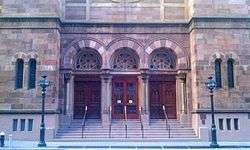 The entrance to the synagogue (2012)
The entrance to the synagogue (2012)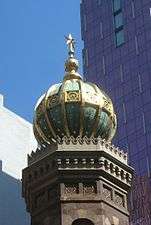 Moorish Revival detail, south tower of the Central Synagogue (2011)
Moorish Revival detail, south tower of the Central Synagogue (2011)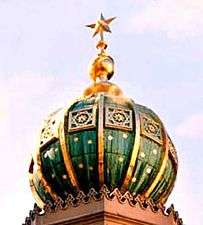 The onion dome and star at the top of one of the towers (2012)
The onion dome and star at the top of one of the towers (2012)
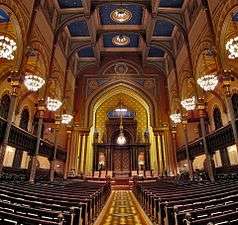 Interior (2010)
Interior (2010)- A detail of the interior (2010)
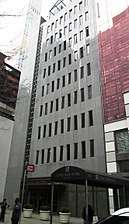 The Coffey Community House at 123 East 55th Street, around the corner from the synagogue (2017)
The Coffey Community House at 123 East 55th Street, around the corner from the synagogue (2017)
See also
References
Notes
- 1 2 3 4 5 New York City Landmarks Preservation Commission; Dolkart, Andrew S.; Postal, Matthew A. (2009), Postal, Matthew A., ed., Guide to New York City Landmarks (4th ed.), New York: John Wiley & Sons, ISBN 978-0-470-28963-1 , p.122.
- 1 2 3 4 5 6 White, Norval; Willensky, Elliot & Leadon, Fran (2010), AIA Guide to New York City (5th ed.), New York: Oxford University Press, ISBN 9780195383867 , p.320
- 1 2 3 National Park Service (2010-07-09). "National Register Information System". National Register of Historic Places. National Park Service.
- 1 2 "Central Synagogue". National Historic Landmark summary listing. National Park Service. September 10, 2007.
- 1 2 3 4 5 Staff (July 7, 1966) "Central Synagogue Designation Report" New York City Landmarks Preservation Commission
- ↑ Krinsky, Carol (1996). Synagogues of Europe. New York: Dover Publications. p. 108. ISBN 0-486-29078-6.
- 1 2 Pitts, Carolyn (February 2, 1975). "National Register of Historic Places Inventory-Nomination: Central Synagogue" (pdf). National Park Service. and Accompanying 5 photos, exterior and interior, from 1973 and undated (1.53 MB)
- ↑ Bahamón, Alejandro and Losantos, Àgata (2007) New York: A Historical Atlas of Architecture New York: Black Dog and Leventhal. p.99
- ↑ Gordon, Mark W. (1966) "Rediscovering Jewish Infrastructure: Update on United States Nineteenth Century Synagogues" American Jewish History 84.1 pp.11-27
- 1 2 3 Dunlap, David W. (2004). From Abyssinian to Zion: A Guide to Manhattan's Houses of Worship. New York: Columbia University Press. ISBN 0-231-12543-7. , p.40
- ↑ Gray, Christopher (2003) New York Streetscapes (1st Edition) Harry N. Abrahams. p.188. ISBN 0-8109-4441-3
- ↑ Harris, Bill (2002) One Thousand New York Buildings, 1st Edition; Black Dog and Leventhal. p.272. ISBN 1-57912-443-7
Bibliography
- Kalmar, Ivan Davidson (2001). "Moorish Style: Orientalism, the Jews, and Synagogue Architecture" (PDF). Jewish Social Studies History Culture and Society. 7 (3): 68. doi:10.2979/JSS.2001.7.3.68. Archived from the original (PDF) on 2008-04-08. Retrieved 2008-03-19.
External links
| Wikimedia Commons has media related to Central Synagogue. |

